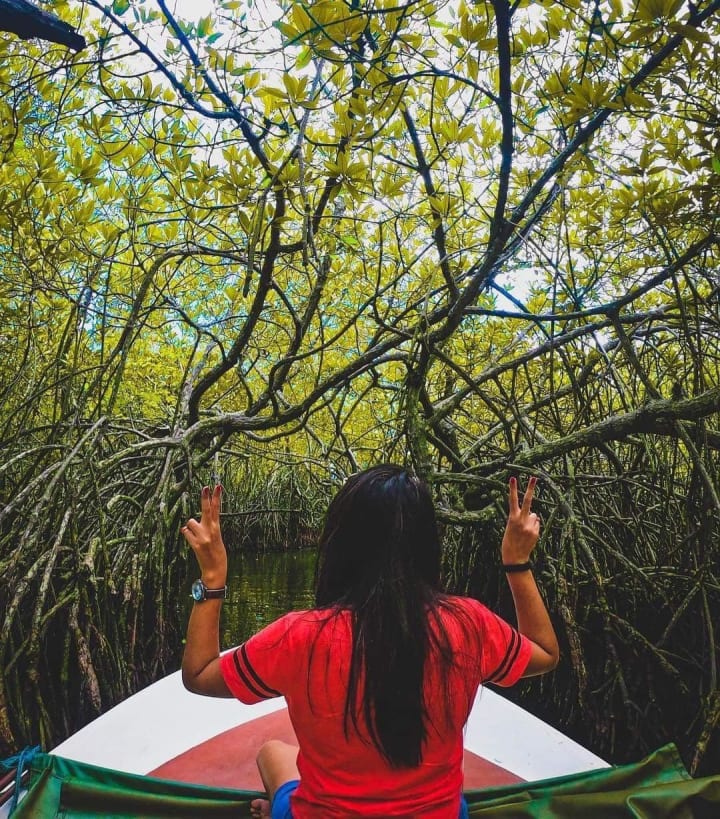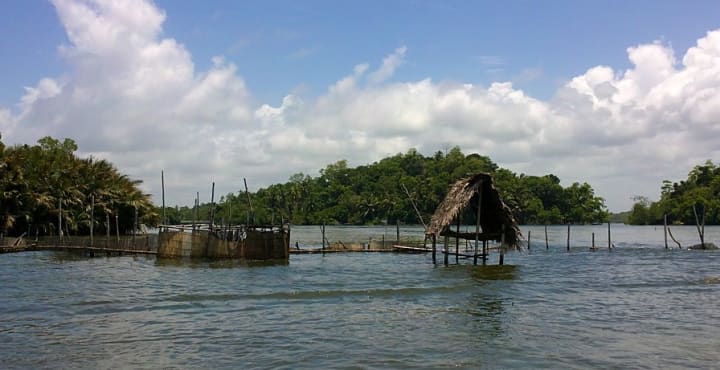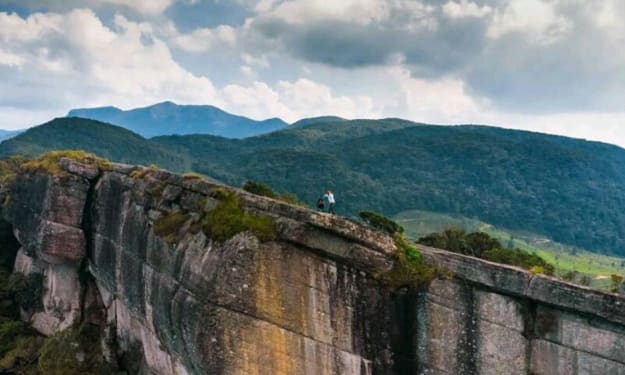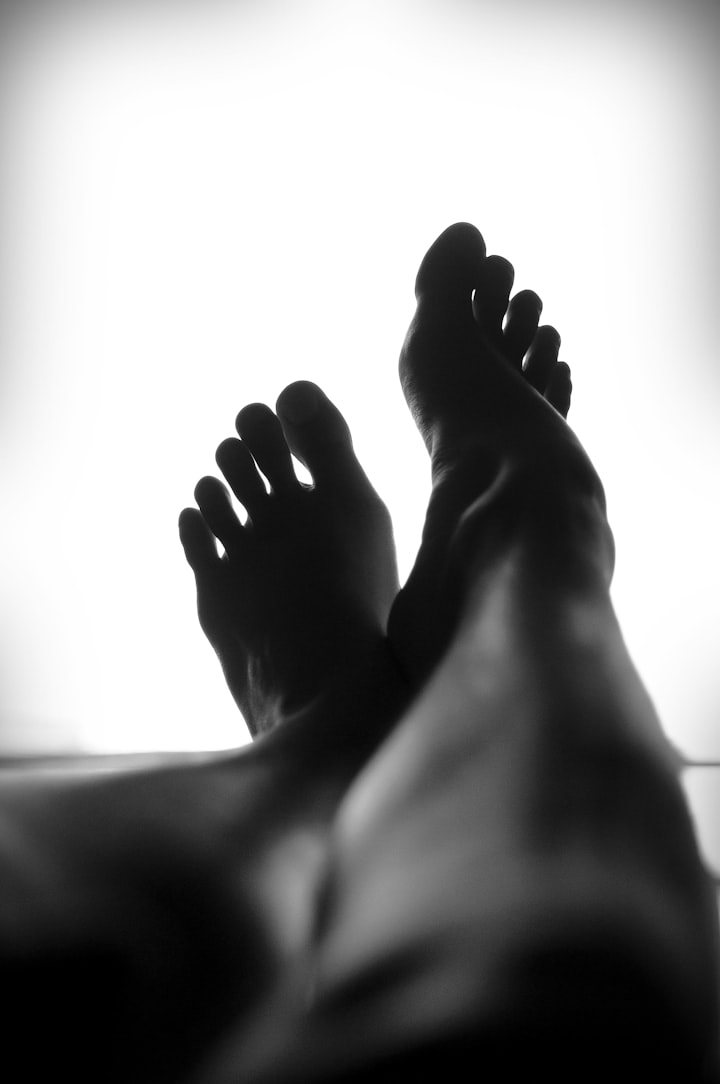
In the Galle District of Sri Lanka, Madu Ganga is situated adjacent to the town of Balapitiya. The name, which can alternatively be spelled "Maduganga" or "Madhu Ganga," means "Madu River." The main road A2 crosses the Madu Ganga river mouth halfway between the two well-known coastal towns of Bentota and Hikkaduwa. This Madu River creates a complex network of mangrove swamps farther upstream, as well as a large open lake studded with islands.
The biggest surviving mangrove swamp in Sri Lanka and an amphibious environment, Maduganga is home to several fish and reptile species. It's a great place to go bird-watching as well. Together with the smaller Random Lake, which is located farther south but closer to the coast, and connected to the Madu River by two natural channels, it creates the Madu Ganga Wetland, which is home to almost 250 species of vertebrate animals and more than 300 species of plants. The International Ramsar Convention on Wetlands, a global agreement for the conservation and sustainable use of wetlands, classified Madu Ganga due to its rich biodiversity. The Iranian city of Ramsar, where the Convention on Wetlands was signed in 1971, bears its name.
The lagoon is another name for the lake. However, because it is a river lagoon, the water is not as salty as saltwater lagoons that open to the ocean and are just mildly brackish. The Madu Ganga still qualifies as a freshwater lake. Only Kalutara and Bentota, on Sri Lanka's southwest coast, are their actual seawater lagoons. The other so-called lagoons are all connected to the ocean via running tiny rivers rather than large gaps. Between Colombo and Galle, there is essentially a network of these somewhat salinized river lagoons, including Bolgoda Lake in Moratuwa, Owinka Lake, Dedduwa Lake, Madu Ganga, Madampe Lake, Hikkaduwa Ganga, Ratgama Lake, with Madu Ganga being by far the biggest.
The Madu Ganga river bed, the constrained channel that connects the lake with the ocean, will be followed in the first segment of the boat excursion upstream. The largest mangrove swamp in the entire wetland area is located between Madu Ganga Lake, Random Lake, and the ocean, yet it is not the only one. The beautiful green setting is reminiscent of a picture book with a tropical river.
Not only do international tourists visit Madu Ganga, but also many locals, especially on the weekends. Along the river's banks are a number of upscale hotels and guesthouses. Some of them provide wedding venues and ballrooms. Those Sri Lankans who can afford it chooses to have their wedding celebrations in luxurious settings.

Mangrove swamps
The Madu Ganga Lake's islands in particular and nearly all of its sides are covered in dense mangrove growth. At least twice throughout your boat voyage, you should glide through a mangrove thicket while passing through the tunnels of the forest. More than 60 hectares make up the mangrove forest. There are 14 different species of mangroves here. Lumnitzera littorea, a member of the genus known as "black mangrove," is a characteristic mangrove species found in Madhu Ganga that Sinhalese name "Rathamilla." Despite the flower's English name, it is intensely red; the Sinhala term "rathu" alludes to the color red.
Madu Ganga is of significant ecological value because of its mangrove swamps, which are home to 31 species of reptiles, including crocodiles, lizards, and snakes. The Madu Ganga Wetland is home to 25 species of mollusks and more than 50 species of butterflies. This region is home to 20 percent of Sri Lanka's amphibian species, including tree frogs, aquatic frogs, and narrow-mouthed frogs.

Fish Massage Spas
You may get a free natural fish massage by taking a Madu Ganga boat excursion. Within the Madu Ganga Wetland region, there are currently many fish spas. However, a local fish farm owner recently launched fish spa therapy after visiting facilities of a similar nature in Thailand. Additionally, it is particularly well-liked in Vietnam and Cambodia.
A natural foot massage using hundreds of fish is called fish spa therapy. You merely have to dip your feet into the ocean while perched on a pier. The calloused epidermis of your feet will soon be eaten away by fish, leaving just the dead scarf skin. A nominal fee is charged to visitors who arrive by boat for this experience. For at least ten minutes, you should keep your feet in the fish spa.
There are several varieties of doctor fish to pick from. In fish spas, two fish species are often employed. Garra Rufa, an authentic doctor fish, hails from the Middle East. Because they feed on psoriasis sufferers' skin and reduce the symptoms of this chronic illness, they have been used in medical therapies. Mozambique tilapia is an additional species utilized in fish spa therapies. The latter are different because they have teeth. Treatment for tilapia isn't unpleasant, though. The fish at Madu Ganga fish spas are kept in their natural habitat, which makes them special. Instead of closed basins as in Thailand, constructed cage ponds in the river are where the fish massage is performed.

Monastery an island in Madu Ganga Lake called Kodduwa
A Madu Ganga islet called Koddhuwa, also known as Koth Doowa, is large enough to hold a full vihara, complete with monks' dells and apartments, image homes, and Bo-trees. It is believed that the Kothduwa Rajamaha Viharaya predates the establishment of Buddhism in Sri Lanka. Without a doubt, it was there during the Kandyan era. But in the late 19th century, it had to be entirely reconstructed. An ordinary citizen by the name of Samson Rajapakse started the renovation. Madhu Ganga was significant in the early history of Sri Lankan Buddhism since it was around this lake that the Buddhist order known as Amarapura Nikaya was founded.

Cinnamon Island
Kurundu Doowa, which is often spelled Kurundu Duwa, is one of Madhu Ganga's most notable cultural landmarks. "Cinnamon Islet" or "Cinnamon Isle" are the translations of this. It is also known as "Cinnamon Island," albeit this is a deceptive name. During the colonial era, Ceylon's whole island was referred to as "Cinnamon Island." The family of G. H. Premadasa, a producer of cinnamon, resides on the islet, and they are gracious enough to teach guests how to peel cinnamon in order to make cinnamon oil. There are more cinnamon growers in the Madu Ganga region besides Mr. Premadasa. Actually, outside fishing, the residents' primary source of income is the cinnamon business.
Cinnamon is not less costly in tourist areas than it is in stores. However, if you buy cinnamon or cinnamon oil from a place you've been to, you can be sure it's fresh and of the highest quality. And the greatest and most authentic cinnamon is cultivated in this region of the world. Although cinnamon was originally cultivated in the wild in the Kandyan hill region, more than 80% of Sri Lanka's cinnamon, which is of unmatched quality, is produced in the Galle District and the nearby districts of Matara, Ratnapura, and Kalutara.
Cinnamon possesses essential oils in its leaves, bark, and roots, yet they are all very distinct chemically. Cinnamaldehyde and eugenol are the two main chemicals found in the oils from the bark and leaves, respectively.

Natural Lake of Madu Ganga
The largest natural lake in Sri Lanka is Madu Ganga. Although Sri Lanka has numerous larger lakes, they were all created by humans in both ancient and modern times for irrigation. The area of Madu Ganga Lake, which spans 5 kilometers from north to south, is roughly 10 kilometers square. However, there are only open water surfaces in 80% of this region. Despite being known as "32 Islands," there are really 25 islands of various sizes, 15 of which contain a sizable amount of land mass. Only trees and plants cover the majority of them; some are inhabited. The locals think that there used to be 32 or 64 additional islets, but some of them were swamped and vanished over time. Actually, by retaining water during the monsoon rains, the lake aids in flood management. Cormorants are frequently seen at the lake while traveling by boat, and you have a high chance of seeing kingfishers while strolling along the shores of an island. The Madu Ganga Wetland is home to over a hundred different kinds of birds.

Ma Doowa island
The largest island in the Lake of Madu Ganga is known by the name Ma Doowa, sometimes known as Ma Duwa. Its diameter is about one kilometer. It is, in fact, the largest island in the nation and one of the few that is populated. On Ma Doowa, about 300 households reside. The 330-meter-long bridge that links Ma Doowa and Balapitiya across the lake is the primary draw of the islet. The Ma Doowa bridge was Sri Lanka's longest until 2009, when the Kinniya Bridge was built to span the mouth of the Mahaweli River at Trincomalee. It is secure for bicyclists and pedestrians, although it is only narrow enough for three-wheelers to utilize.

Satha Paha Duwa
"Satha Paha Duwa" is the name of the smallest islet in Madu Ganga Lake. Translations of "Paha" and "Satha" are "five" and "cent," respectively. The islet had originally been acquired for five cents, according to local legend. Others, however, contend that the term derives from the object's size or form, which is similar to a little coin. Fice-Cent-Island is nevertheless large enough to support a temple. The temple is devoted to Kataragama, a god worshipped by Weddah animists, Tamil Hindus, and Sinhalese Buddhists equally. It resembles a Devale, a Buddhist temple dedicated to a Hindu god.

Ja kotu
Many fish species have spawning grounds in the Madu Ganga Lake. In sections of the Madu Ganga's shallow portions, you may observe pots for prawn catching. The traditional fishing kraals known as "Ja-kotu" in Sinhala are used by fishermen. On the traps, lamps are lit in the evening. In small stretches of the river, ropes close to the water's surface are intended to slow down motor boats, thus boatmen are careful to raise the motor to avoid hitting them. By doing so, waves are diminished, which prevents riverbank erosion.

Google Map:
About the Creator
Zeloan
I'm a Traveller, Blogger, and Content Creator. Visit Sri Lanka, and you can see the most beautiful places in the world and the remarkable hospitality here






Comments
There are no comments for this story
Be the first to respond and start the conversation.